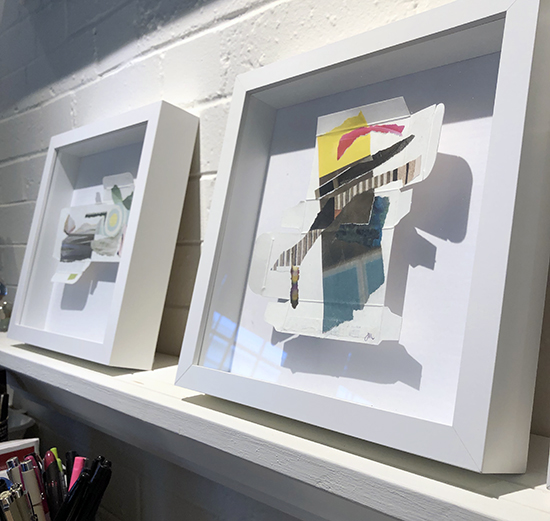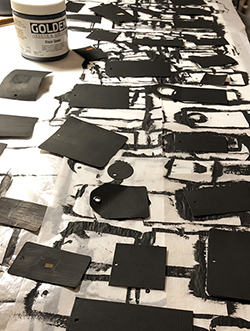The pieces in my upcoming “Gesture and Flow” exhibition (May/June 2023) make my interest in line and type more apparent than in any body of work I’ve produced before. The backstory that got me here seems worthy of exploring.
As a graphic design student at Oregon State University, an incredibly thorough understanding of typography was demanded. This was pre-computer so we were drawing letterforms and roughing in text blocks by hand for our projects. The curriculum also included a full year of calligraphy courses (thank you, Allen Wong). By senior year we were able to access and incorporate rub-on (Letraset) type. We also learned how to mark up text and specify typesetting so it could be ordered from actual typographers.
As a senior, I had an internship in the campus Office of Publications under the amazing mentorship of Marilyn Holsinger (both an ace designer and a talented calligrapher).
Shown here is the outside spread from one of my first projects under Marilyn’s influence. It incorporates wave forms that I designed, then carefully inked by hand onto mylar.
Brochure spread measures 11 x 11”, folds to 5.5” x 11”, circa 1978 (!)
Although most of the University’s materials were photo-typeset, the class catalog (about the size of a phonebook) was still being set with hot metal on Linotype machines which made a distinctive and impressive racket. It was amazing to witness the whirlwind of change that eventually ushered in digital typesetting. The campus print shop had a full range of printing equipment too.
I consider it a gift to have seen all of the processes and machinery in action. I learned so much about the evolution of typesetting and printing practices from a hands-on perspective. (During the internship Marilyn also used me as an occasional model for campus promotional materials — that’s me back in the day.)
This background always informed my design work and 40+ year career. I occasionally developed gestural calligraphic and strongly-lined woodblock illustrations to use in client projects. And all the while, I was also pursuing my interest in collage, at first in a limited way, but by the late 1990’s I was very focused on collage as a complement (and antidote) to my computer-based design work.
Hand-carved woodblock print made to illustrate a client brochure, approximately 10 x 8”, circa 2003.
When the Covid lock-downs began in 2020, while on extra-long Zoom calls, I began altering magazine photos with marks, patterns, and asemic writing. I have used fragments from some of those images in a few collages, like these, made in response to a call for art sponsored by the Doug + Laurie Kanyer Art Collection. I still have a big folder of patterned elements that may come into play in future collages.
Small collages, each just 1” square, using some elements that were altered with white ink, 2020
A small pile of my inked-upon collage elements. I usually make the marks while the imagery is still in the magazine, and them rip pieces out to get the shapes/bits I want for a project.
As you might imagine, there is more to the story of incorporating markmaking with collage — so this is the first of one (or a few?) more post/s to come.
















